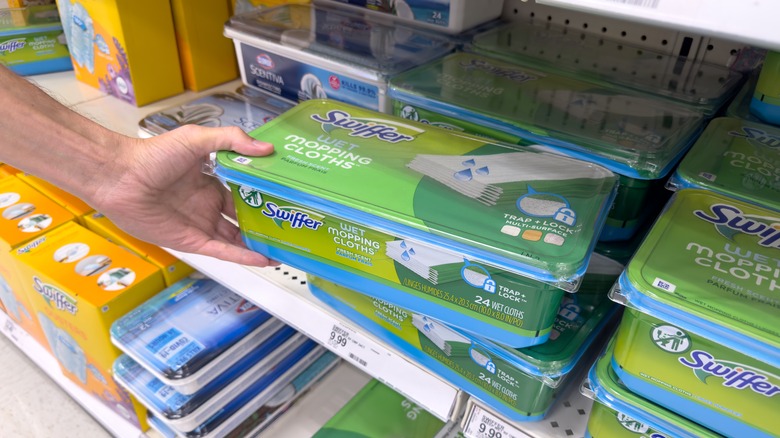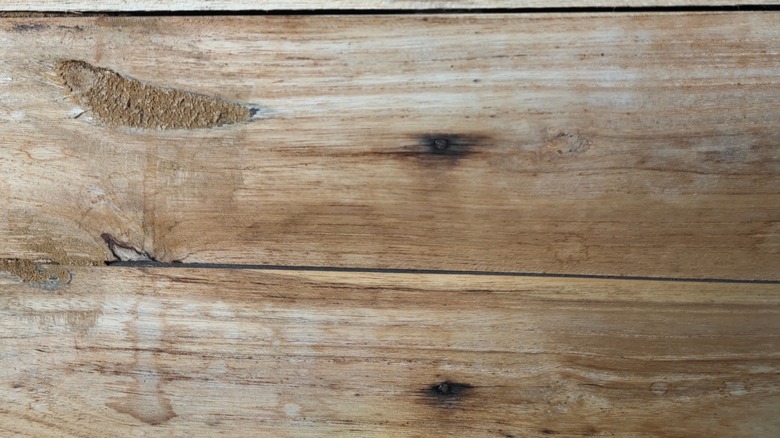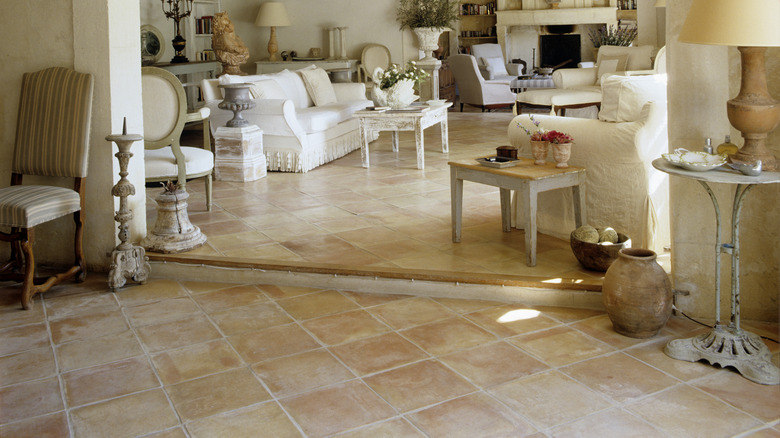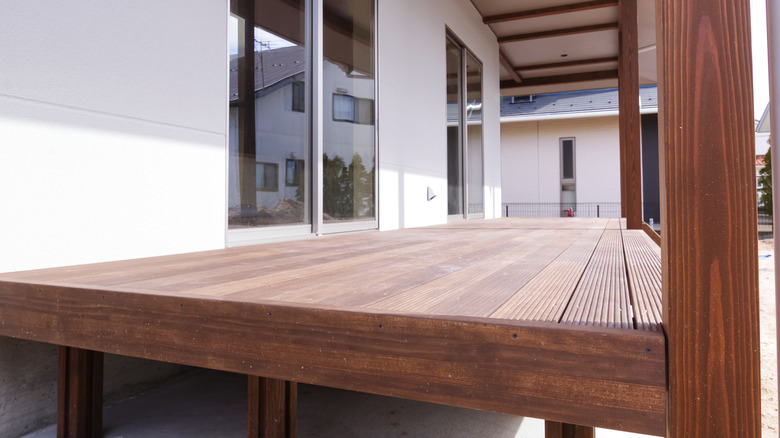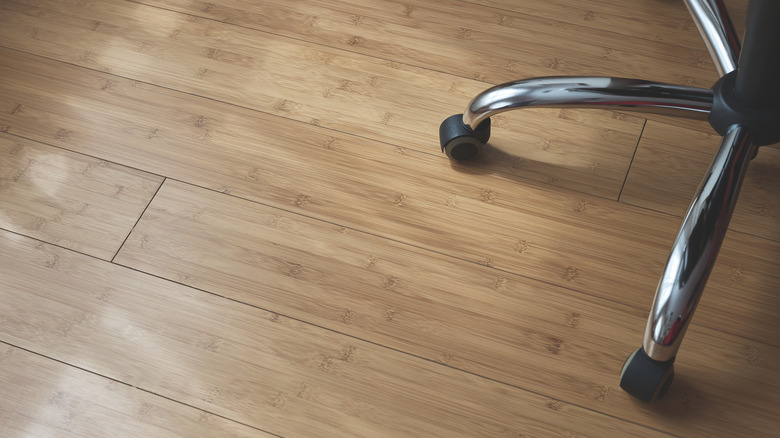10 Things You Should Avoid Cleaning With A Swiffer At All Costs
We may receive a commission on purchases made from links.
Swiffer WetJet mops and wet pads have become a poster child for quick, convenient cleaning. They're lightweight, easy to maneuver, and come preloaded with cleaning solutions. For busy homeowners or anyone who hates dragging out a heavy mop and bucket, the Swiffer's grab-and-go appeal can feel like an answer to prayer, but there's one caveat: They are not the right choice for every surface in your home. –
The cleaning solution, pad texture, and moisture levels can sometimes do more harm than good, causing warping, residue buildup, or even permanent damage to delicate materials. Some surfaces need a gentler touch, while others require a deeper clean than a Swiffer can deliver. These are the drawbacks to consider before buying a Swiffer mop or using it on any surface. Knowing when not to use your Swiffer can help you protect your floors, save money on repairs, and keep your home looking its best. Let's explore 10 specific spots and surfaces you should avoid, as well as how best to keep your floors clean for longer without damage.
Unfinished wood floors are listed by Swiffer as a no-go
Unfinished wood floors are beautiful for their raw, natural look, but they're also quite vulnerable to damage. The Swiffer WetJet's cleaning solution is water-based and designed to break down dirt quickly. Swiffer warns not to use their solution on unfinished wood. On an unfinished wood surface, that moisture can potentially penetrate the grain, causing the boards to swell or even crack over time. Cleaning agents not meant for unsealed wood may also leave blotches behind. These floors lack a protective sealant, and as such, they absorb liquids rapidly, and once water damage sets in, it's often irreversible without costly sanding or replacement.
For unfinished wooden boards, dry cleaning methods are the safest choice. Start with a soft-bristle broom or microfiber dust mop to remove dust and grit without scratching the surface. For deeper cleaning, use a barely damp microfiber cloth with plain water or a wood-safe cleaner formulated specifically for unfinished floors, applied sparingly. Always wipe the area dry immediately to prevent moisture from soaking in. By avoiding wet cleaning methods like the Swiffer WetJet, you'll preserve its integrity and keep your wood floor looking like new for years.
Swiffer cleaning solutions could eat away at the sealant on concrete floors over time
Concrete might seem indestructible, but it's surprisingly sensitive to the wrong cleaners, especially if sealed or polished. The cleaning solution used in a Swiffer WetJet has a pH that's too alkaline for polished and sealed concrete. Over time, these extremes can create dull spots, weaken the sealant or finish layer, or make the floor more porous and prone to staining. That's a costly mistake to fix, especially for decorative concrete in basements, patios, or garages, or polished interior concrete floors.
For sealed or polished concrete, stick to a pH-neutral cleaner recommended for stone or masonry surfaces, applied with a microfiber mop or a damp sponge mop. Avoid excess water and try not to let moisture pool while mopping. For unsealed or rough concrete, sweep with a stiff-bristle broom. You can try using a microfiber flat mop to clear debris, if it will pass over without catching on the surface. If a deeper clean is needed, use a soft scouring pad and lightly scrub with warm water and a small amount of mild soap, then rinse with clean water and let the area dry completely.
Swiffer mops can leave too much moisture in carpeted floors or area rugs
Swiffer WetJet mops and wet pads are specifically designed for sealed hard surfaces like wood, tile, or vinyl and not for carpets or area rugs. Another issue is that carpets require deep cleaning to remove dirt, dust, and allergens embedded in the fibers. Using a WetJet on a rug or carpet could push moisture deep into the fibers without extracting it afterwards, which can lead to mold, mildew, or lingering odors.
For everyday maintenance, a high-quality vacuum cleaner, preferably with a crevice tool, is the best option for carpets and area rugs. It lifts and removes dirt from deep in the fibers. For spot cleaning spills, blot immediately with a clean cloth and use a carpet-safe cleaning solution, following the product's instructions to avoid discoloration. Periodically, a steam cleaner can remove built-up grime and allergens, restoring the texture and appearance. If you have small rugs, consider shaking them out outdoors to release dust before vacuuming.
Natural stone floors require gentle, pH-neutral cleaners
Natural stone floors like marble, limestone, travertine, and slate are elegant but delicate surfaces that require special care. The Swiffer WetJet solution, with a pH of around 10, can be detrimental to natural stone floors, especially marble. This alkaline formula can damage the finish, leaving the floor more vulnerable to staining from everyday spills. The porosity of marble can result in etching, dull spots, and loss of its natural shine. Even granite, while slightly less sensitive, can suffer from gradual etching, discoloration, and damage to the sealant if repeatedly cleaned with unsuitable solutions. Because natural stone is a long-term investment in a home, improper cleaning can lead to costly restoration work.
For natural stone floors, stick to pH-neutral cleaners specifically designed for stone care (such as Granite Gold's Stone And Tile Floor Cleaner). These products clean effectively without breaking down sealants or etching the surface. Always follow up with a soft, damp microfiber mop that won't cause micro-scratches. For quick maintenance, dry-dust with a microfiber dust mop to remove loose debris before it has a chance to scratch the stone. If you're dealing with spills, blot immediately instead of wiping to prevent spreading. Periodic resealing, depending on the type of stone and foot traffic, will keep the surface protected and easier to clean.
Wood decks can be too rough and dirty for a Swiffer mop to handle
While Swiffer WetJet mops and wet pads are great for smooth, sealed indoor floors, they're not suited for cleaning wood decks. The rough texture of wood decks makes it hard for the WetJet's gentle glide and light pressure to remove outdoor grime, mold, pollen, or embedded dirt that collects in the grain and gaps. Deep cleaning is essential because wood decks, especially those exposed to the elements, often need a more thorough cleaning approach to address weather stains, algae, and accumulated dust. Using a Swiffer regularly outdoors would be inefficient and is one of the common mistakes you can make with a Swiffer.
For proper deck maintenance, a more robust cleaning method is essential. A pressure washer is one of the most effective tools for blasting away built-up grime, mildew, and stains without excessive scrubbing in outdoor areas. However be sure to use the correct pressure setting to avoid damaging the wood. For a gentler, safer, but still thorough approach, a soft-bristled scrub brush paired with a deck-safe cleaning solution can help lift dirt from grooves and grain patterns. Regular sweeping to remove leaves and debris will also prevent staining and buildup. Once clean, consider applying a wood sealant or protective stain to shield the deck from moisture and UV damage (just be sure to sand the surface first).
Bamboo floors could develop issues from excess moisture and high pH cleaners
Bamboo may look as tough as hardwood, but it's actually more water-sensitive than many people realize. While it's technically a grass, bamboo flooring is engineered into planks. These planks can swell or discolor when exposed to excess moisture. Swiffer WetJet mops and wet pads release a steady stream of cleaning solution that, if used repeatedly, can seep into seams and cause long-term damage. The issue isn't just water, it's also pH. Swiffer's alkaline cleaning solution can slowly break down the finish and strip the protective coating from bamboo floors. Over time, this combination of moisture and chemical wear can lead to dulling and surface etching. Since bamboo is often chosen for its sleek, uniform look, any warping or discoloration can be especially noticeable.
Bamboo floors thrive with a less-is-more approach. For routine cleaning, a dry microfiber mop or a broom with soft bristles is ideal for removing dust and debris without scratching the surface. If you need a deeper clean, use a barely damp microfiber mop with a pH-neutral cleaner specifically formulated for bamboo or hardwood floors. Always wring the mop until it's just slightly moist and not dripping wet. Immediately follow up by drying the surface with a clean, dry cloth to ensure no moisture lingers. For sticky spots, a small spritz of pH-neutral cleaner directly on the spot followed by wiping with a soft cloth should do the trick.
Waxed or oiled wood floors aren't listed as safe to clean with Swiffer mops or wet pads
Waxed or oiled wood floors have a completely different care requirement than regular hardwood. They are finished with a protective coating that sits on top of or soaks into the wood. However, these finishes are sensitive to the pH levels of the cleaning solution used on them. Additionally, waxed and oiled floors are water-sensitive, meaning wet mopping (even with the relatively small amount of solution from a Swiffer) can cause moisture to seep into the wood, leading to unwelcome wear and tear. Oiled finishes are also prone to uneven spotting when cleaned with water-heavy methods, as moisture can disrupt the oil layer. Over time, using a Swiffer on these floors can break down the very finish that's meant to preserve their beauty.
The safest approach for waxed or oiled wood floors is a dry or lightly damp cleaning method. Use a soft-bristled broom or microfiber dust mop daily to remove dust and grit without scratching the surface. For deeper cleaning, choose a cleaner specifically formulated for waxed or oiled floors (such as WOCA Natural Soap). These products have a neutral pH and often contain conditioning agents to nourish the finish rather than strip it. Lightly spray the cleaner on a microfiber cloth or mop and wipe in the direction of the wood grain. If the floor starts losing its luster, reapply a thin coat of wax or oil as recommended by the manufacturer to restore its protective layer.
The pH of Swiffer Wet Jet solutions could damage the sealant on cork floors
Cork flooring may be beautifully insulating underfoot, but it's naturally porous and prone to absorbing moisture. Even with being sealed, its surface can be sensitive to both water and strong cleaning agents. The Swiffer WetJet solution, with its alkaline pH, can gradually wear down the protective finish on cork, making it more vulnerable to stains, discoloration, and surface swelling. In addition, cork's slightly textured surface can trap the fluid unevenly, leaving blotchy marks that are hard to remove. In short: The combination of alkalinity and moisture is a slow recipe for dulling and damaging the floor.
Cork floors respond best to gentle, low-moisture cleaning methods. Start with a soft broom, vacuum with a hardwood setting, or use a dry microfiber mop to remove daily dust and debris. For occasional deeper cleaning, opt for a cork-safe, pH-neutral cleaner according to the manufacturer's instructions. Apply it using a barely damp microfiber mop, wrung out so that it's almost dry to the touch, in order to avoid excess moisture. If your cork flooring has begun to lose its protective layer, consider reapplying the recommended sealant periodically. This not only enhances its resistance to spills and wear but also makes routine cleaning more effective.
Unsealed tiles are sensitive to liquids, including Swiffer's cleaning solutions
Unsealed tiles, like unglazed ceramic or natural stone, lack the protective coating that makes sealed flooring resistant to moisture and staining. This means that any liquid, including the cleaning solution from a Swiffer WetJet, can slowly get into the tile's microscopic pores and cause long-term issues. Once moisture gets in, it can discolor the surface, or even, in severe cases, destroy the adhesive hold of the tile. While the small amount of moisture from a Swiffer probably won't pop your tiles up, the alkaline nature of Swiffer's cleaning solution may react with the tile material, especially in natural stone flooring, causing etching over time.
When dealing with non-sealed tiles, your cleaning method should prioritize minimal moisture and gentle, pH-neutral solutions. Spray the cleaning agent sparingly on your mop head or directly onto trouble spots rather than flooding the entire floor. For grout lines, use a soft-bristled brush to dislodge dirt, then wipe clean with a barely damp cloth. In high-traffic areas, sweeping or vacuuming regularly prevents abrasive dirt from scratching the surface. If you want lasting protection, consider having your tiles and grout professionally sealed. This not only makes cleaning easier but also greatly reduces the risk of water damage. Until then, avoid using any mop system, like the Swiffer WetJet, that disperses significant liquid across the floor (and pre-loaded cleaning agents that aren't pH-balanced), as it can compromise both the look and longevity of your tiles.
Television screens and electronics shouldn't be exposed to the chemicals in a Swiffer wet pad
Television screens and other electronics are far more delicate than they look, and this places them among the top ten things you should never clean with water. Modern flat screens, whether LED, OLED, or LCD, are coated with an anti-glare or protective layer that can be easily damaged by the chemicals in a Swiffer wet pad. These pads are designed for floors, not sensitive TV coatings. Using them on a screen could leave behind streaks, hazy residue, or worse, cause the coating to damage over time. In addition, the moisture from the wet pad can seep into tiny gaps along the edges of the screen or buttons and ports, potentially leading to internal damage. The same goes for laptops, desktop monitors, and other electronics: Liquid and circuitry are never a good mix. While electronics are some of the things you can clean with Swiffer dusters, the wet versions are far too harsh for them.
When cleaning a TV or electronic screen, think "gentle and dry first." A Swiffer duster can work when you need to gently remove static-attracted dust. A microfiber cloth should be the next step for safely wiping away smudges and fingerprints without scratching. For more stubborn smudges, lightly dampen the microfiber with distilled water or a very diluted mixture of distilled water and white vinegar, making sure the cloth is just barely moist. Always apply the liquid to the cloth, never directly onto the screen, to avoid moisture getting inside the device. Wipe the surface in either up or down motions or side to side from top to bottom, and finish with a dry section of the cloth to remove any streaks. For keyboards, ports, and vents, use a can of compressed air (held a couple of inches away) to dislodge dust without moisture.
